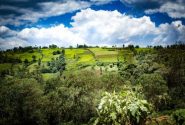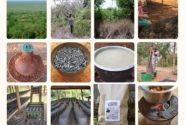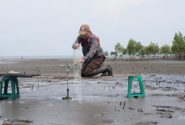BOGOR, Indonesia (5 October, 2012)_Forest-rich countries must ensure that policies for emissions reduction programs, such as REDD+, are based on accurate measurements of carbon stored and released from trees, otherwise they could greatly overestimate their contribution in reducing the planet’s greenhouse gas (GHG) emissions.
Louis Verchot, lead climate change scientist at the Center for International Forestry Research says without these basic metrics it is impossible to gauge the impact forestry policies have on global GHG levels.
“One of the biggest technical challenges to implementing REDD+ is determining what your impact is,” he said. “How much area has been deforested? What is the carbon content of the area that has been deforested? And how much of that carbon content has been transferred from the ecosystem to the atmosphere.”
“You could be telling yourself that you’re having a positive impact when you are not. Understanding carbon emissions is fundamental to actually having an impact on the atmosphere.”
More than 40 countries are now moving ahead with projects to reduce emissions deforestation and forest degradation, or REDD+; an international mechanism designed to reduce carbon emissions by financially assisting developing countries to protect their forests. REDD+ success is said to depend on accurately measuring the carbon stored and released from forests.
Reaching that goal is the focus of a four-year old global comparative study on Reducing Emissions from Deforestation and Forest Degradation schemes, which aims to support developing countries develop the technical capacity.
Across the globe, teams of CIFOR researchers are measuring carbon and other gases stored in a wide variety of forests – virgin forests, degraded forests and in destroyed forest areas – to get a bigger picture of their overall impact on the atmosphere.
“The ability to quantify the amount of carbon is going to be important because it will help us, over the next seven to ten years, build up countries’ greenhouse gas inventories and facilitate carbon accounting…This is a technical issue that we can solve or make significant progress on.”
Forest rich countries in the tropics usually lack inventories or historical records of their forests, including the amount of carbon they contain. By providing a baseline for carbon accounting in these forests, CIFOR research will help ground policy decisions and activities related to REDD+.
In Indonesia, peat forest areas store vast amounts of carbon accumulated in the waterlogged soils below ground. When they are cut down and the peat is drained to plant crops such as oil palm, large amounts of carbon dioxide are released into the atmosphere.
“For every year that peat is drained, an additional 8 to 12 tons of carbon per hectare is released into the atmosphere,” said Verchot.
CIFOR scientists have estimated 60-80 percent of emissions alone come from the peat soils, yet Verchot warns, “Peatlands are some of the areas in Southeast Asia that are changing the most rapidly and we know the least about their carbon density.”
“The reason it is difficult [to measure] is because the emissions are persistent from peatlands,” he says. “When you drain peat, you expose [carbon] that was otherwise protected, because flooded peat is anaerobic – there’s no oxygen so there is little decomposition.”
How to measure carbon emissions?
To measure greenhouse gases in forests, researchers travel into remote areas with equipment that takes samples of soil, vegetation, water and air for analysis back in the lab.
Jody Harthill, a PhD student and researcher at CIFOR, reminds her local field assistants when they arrive in the forest in Sumatra that smoking their cigarettes is forbidden around the research plots.
The research plots sit on 162,000 hectares of virgin peat swamp in Berbak National Park, a full’s day travel by boat from the capital of Jambi province in Sumatra. Smoking on the plots’ grounds could contaminate the gas samples they are collecting – data that could eventually assist policy makers in the future management of forests.
Back in the lab in Jambi, Harthill and other researchers analyse the data collected to compare gas fluxes released into the atmosphere by virgin forests and the decomposing peat soils beneath oil palm plantations.
“This palm oil plantation [we’re measuring] is vast, the area of peat we are on is vast, and it follows that the volumes of gases they contain would be enormous,” she says.
“But they represent only a small proportion of what is happening across the globe. Scaling up efforts to measure these carbon emissions could have really big impact on climate change.”
Harthill’s research will help countries like Indonesia to measure, report and verify (MRV) their carbon emissions as accurately as possible. In particular, countries will need to measure carbon stock changes and other greenhouse gas emissions resulting from land use and land-use changes, including those in forest areas.
“To make it simplistic, we could compare carbon stocks to a bank account; CIFOR is trying to calculate how much money [carbon] is saved or lost during the year by recording the balance of transfers in and out of the account [the ecosystem]”, said Kristell Hergoualc’h, a CIFOR scientist also working on the study.
The way forward could be to enhance collaboration between research institutes, forestry and agriculture university faculties and other relevant research institutes and intergovernmental agencies.
By sharing technical skills and increasing coordination with other institutions such as CIFOR, developing countries could improve the design and efficiency of their REDD+ programmes, said Verchot.
“It is about targeting your interventions so you get the most bang for your buck: so that when you invest money in REDD+, you actually get the highest emissions reductions possible or the lowest cost emission reductions possible.”
With additional reporting by Catriona Moss and Andrea Booth.
This article was first published by Responding to Climate Change as part of a week of forest stories. Follow the week’s reports on Twitter via #ForestWeek and leave your views on our Facebook page.
We want you to share Forests News content, which is licensed under Creative Commons Attribution-NonCommercial-ShareAlike 4.0 International (CC BY-NC-SA 4.0). This means you are free to redistribute our material for non-commercial purposes. All we ask is that you give Forests News appropriate credit and link to the original Forests News content, indicate if changes were made, and distribute your contributions under the same Creative Commons license. You must notify Forests News if you repost, reprint or reuse our materials by contacting forestsnews@cifor-icraf.org.













